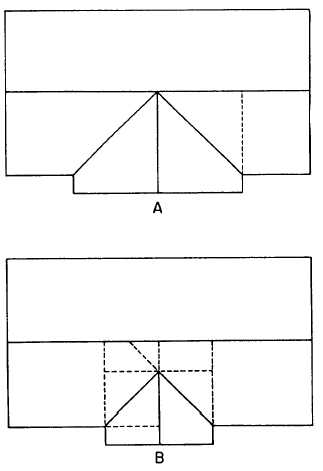The run of valley jack Nos. 9 and 10 is equal to
the spacing of jacks OC. Therefore, the length of
one of these jacks is equal to the common
difference of jacks.
The run of valley jacks Nos. 11 and 12 is twice
the run of valley jacks Nos. 9 and 10, and the
length of one of these jacks is therefore twice the
common difference of jacks.
The run of valley cripple No. 13 is twice the
spacing of jacks OC, and the length is therefore
twice the common difference of jacks.
The run of valley cripple No. 14 is twice the run
of valley cripple No. 13, and the length is there-
fore four times the common difference of jacks.
SHORTENING ALLOWANCES.— A hip jack
has a shortening allowance at the upper end, consisting
of one-half the 45° thickness of the hip rafter. A valley
jack rafter has a shortening allowance at the upper end,
consisting of one-half the 45° thickness of the ridge, and
another at the lower end, consisting of one-half the 45°
thickness of the valley rafter. A hip-valley cripple has a
shortening allowance at the upper end, consisting of
one-half the 45° thickness of the hip rafter, and another
at the lower end, consisting of one-half the 45° thickness
of the valley rafter. A valley cripple has a shortening
allowance at the upper end, consisting of one-half the
45° thickness of the long valley rafter, and another at the
lower end, consisting of one-half the 45° thickness of
the short valley rafter.
SIDE CUTS.— The side cut on a jack rafter can be
laid out using the same method as for laying out the side
cut on a hip rafter. Another method is to use the fifth line
of the unit length rafter table, which is headed SIDE
CUT OF JACKS USE (fig. 2-41). If you follow that line
over to the figure under 8 (for a unit of rise of 8), you
will see that the figure given is 10. To lay out the side
cut on a jack set the square faceup on the edge of the
rafter to 12 inches on the tongue and 10 inches on the
blade, and draw the side-cut line along the tongue.
BIRD’S-MOUTH AND PROJECTION.— A jack
rafter is a shortened common rafter; consequently, the
bird’s-mouth and projection on a jack rafter are laid out
just as they are on a common rafter.
Ridge Layout
Laying out the ridge for a gable roof presents no
particular problem since the line length of the ridge is
equal to the length of the building. The actual length
includes any overhang. For a hip main roof, however,
the ridge layout requires a certain amount of calculation.
As previously mentioned, in an equal-pitch hip roof,
the line length of the ridge amounts to the length of the
building minus the span. The actual length depends
upon the way the hip rafters are framed to the ridge.
As indicated in figure 2-54, the line length ends of
the ridge are at the points where the ridge centerline and
the hip rafter center line cross. In the figure, the hip rafter
is framed against the ridge. In this method of framing,
the actual length of the ridge exceeds the line length, at
each end, by one-half the thickness of the ridge, plus
one-half the 45° thickness of the hip rafter. In the figure,
the hip rafter is also framed between the common
rafters. In this method of framing, the actual length of
the ridge exceeds the line length at each end by one-half
the thickness of a common rafter.
Figure 2-55, view A, shows that the length of the
ridge for an equal-span addition is equal to the length of
the addition top plate, plus one-half the span of the
building, minus the shortening allowance at the
Figure 2-55.—Lengths of addition ridge.
2-33

